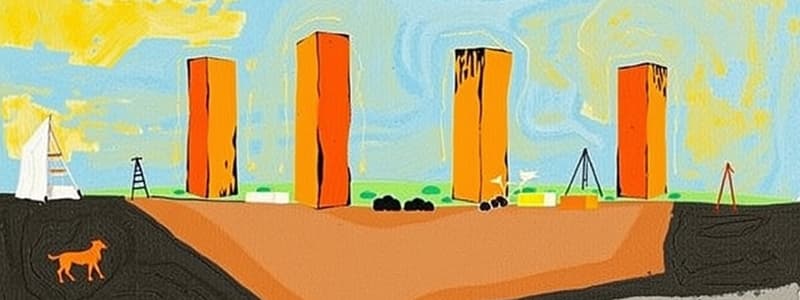Podcast
Questions and Answers
What is the primary assumption of the upper bound approach in structural analysis?
What is the primary assumption of the upper bound approach in structural analysis?
- Exact solution is not achievable
- Failure mechanism is assumed (correct)
- Failure mechanism is ignored
- Ultimate capacity is always lower than the load
What is a characteristic condition for shallow foundations?
What is a characteristic condition for shallow foundations?
- D ≤ B (correct)
- D = B
- D > B
- D < 2B
Which type of foundation is categorized under shallow foundations?
Which type of foundation is categorized under shallow foundations?
- Caissons
- Strip footing (correct)
- Piles with a pile cap
- Drilled shafts
What caused the failure of the foundation soil under the Transcona Grain Silos?
What caused the failure of the foundation soil under the Transcona Grain Silos?
What ratio defines the embedment of shallow foundations?
What ratio defines the embedment of shallow foundations?
What remediation methods were applied to the Transcona Grain Silos after the foundation failure?
What remediation methods were applied to the Transcona Grain Silos after the foundation failure?
What must be true about the failure load in the upper bound approach?
What must be true about the failure load in the upper bound approach?
Which criterion states that the applied load must be less than the strength of the soil?
Which criterion states that the applied load must be less than the strength of the soil?
What year was the Transcona grain elevator built?
What year was the Transcona grain elevator built?
In the context of failure of shallow foundations, what method of analysis assumes the state of stresses at failure?
In the context of failure of shallow foundations, what method of analysis assumes the state of stresses at failure?
Which company purchased the Transcona grain elevator in 1970?
Which company purchased the Transcona grain elevator in 1970?
Which of the following is not a type of shallow foundation?
Which of the following is not a type of shallow foundation?
What is the allowable bearing capacity equation used for?
What is the allowable bearing capacity equation used for?
What type of foundation failure is exemplified in the Transcona Grain Silos case?
What type of foundation failure is exemplified in the Transcona Grain Silos case?
Which of the following statements about structural failure is correct?
Which of the following statements about structural failure is correct?
Which condition must be true for a foundation to be considered a shallow foundation?
Which condition must be true for a foundation to be considered a shallow foundation?
Which of the following is an example of a shallow foundation design?
Which of the following is an example of a shallow foundation design?
What does the serviceability criterion involve in foundation design?
What does the serviceability criterion involve in foundation design?
What does the term Nc represent in the bearing capacity equation?
What does the term Nc represent in the bearing capacity equation?
In Terzaghi’s Bearing Capacity Equation, what does the term $q_0$ represent?
In Terzaghi’s Bearing Capacity Equation, what does the term $q_0$ represent?
How is the bearing capacity factor Ng calculated in relation to the friction angle?
How is the bearing capacity factor Ng calculated in relation to the friction angle?
What is the purpose of the bearing capacity factors Nc, Nq, and Ng in the equation proposed by Terzaghi?
What is the purpose of the bearing capacity factors Nc, Nq, and Ng in the equation proposed by Terzaghi?
Which of the following describes Terzaghi's Bearing Capacity Equation?
Which of the following describes Terzaghi's Bearing Capacity Equation?
What is one of the significant aspects of the equation $q_u = cN_c + q_0 N_q + 0.5 gBN_g$?
What is one of the significant aspects of the equation $q_u = cN_c + q_0 N_q + 0.5 gBN_g$?
How can the empirical equation for Kpg be summarized?
How can the empirical equation for Kpg be summarized?
What is the significance of the bearing capacity equation first proposed by Terzaghi in 1943?
What is the significance of the bearing capacity equation first proposed by Terzaghi in 1943?
What is the bearing capacity equation for circular footings?
What is the bearing capacity equation for circular footings?
Which type of soil is associated with punching shear failure?
Which type of soil is associated with punching shear failure?
What characterizes general shear failure?
What characterizes general shear failure?
What adjustment is required for local shear failure in bearing capacity equations?
What adjustment is required for local shear failure in bearing capacity equations?
In which type of failure is there typically no heave observed?
In which type of failure is there typically no heave observed?
What does the factor 0.5 represent in the bearing capacity equation for rectangular footings?
What does the factor 0.5 represent in the bearing capacity equation for rectangular footings?
What does the term 'qo' represent in bearing capacity equations?
What does the term 'qo' represent in bearing capacity equations?
What is the formula used for calculating the design cohesion in local or punching shear failure?
What is the formula used for calculating the design cohesion in local or punching shear failure?
What type of strength parameters should be used for effective stress analysis in drained conditions?
What type of strength parameters should be used for effective stress analysis in drained conditions?
Which of the following statements is true regarding undrained analysis?
Which of the following statements is true regarding undrained analysis?
What happens to pore pressure in undrained conditions during loading?
What happens to pore pressure in undrained conditions during loading?
In a drained analysis, how should the water table be considered?
In a drained analysis, how should the water table be considered?
Which parameter should be used to determine unit weight of soil when the water table is at or above the foundation base?
Which parameter should be used to determine unit weight of soil when the water table is at or above the foundation base?
What is the effective friction angle in undrained conditions for saturated normally consolidated clay?
What is the effective friction angle in undrained conditions for saturated normally consolidated clay?
In a total stress analysis, how does the water table affect the analysis?
In a total stress analysis, how does the water table affect the analysis?
Which of the following parameters is not used in undrained strength analysis?
Which of the following parameters is not used in undrained strength analysis?
Flashcards are hidden until you start studying
Study Notes
Types of Foundations
- Foundations are categorized into shallow and deep foundations.
- Shallow foundations include mat or raft and pad footings.
- Deep foundations typically consist of piles with a pile cap.
Shallow Foundations
- Shallow foundations are defined by the relationship where the depth of embedment (D) is less than or equal to the breadth (B).
- Types include strip footings, circular, square, and rectangular footings.
Definition of Shallow Foundations
- The ratio of embedment depth (Df) to minimum dimension (B) should not exceed 2.5.
Geotechnical Design Criteria
- Strength criterion necessitates that applied loads must be less than soil strength.
- Serviceability criterion requires that deformation remains within acceptable limits.
Failure of Shallow Foundations
- Two analysis methods:
- Lower bound assumes stress states at failure; yields a failure load less than or equal to true ultimate capacity.
- Upper bound assumes failure mechanisms; provides a failure load greater than or equal to true ultimate capacity.
- An exact solution is identified when both methods yield the same result.
Case Study: Transcona Grain Silos
- Built by Canadian Pacific Railway in 1913, the foundation failed due to inadequate soil bearing capacity.
- Remediation included supporting structures and excavation to restore the foundation.
Types of Failure
- General shear failure: characterized by sudden failure and surface heave, typical in dense or stiff soils.
- Local shear failure: occurs in medium-compacted soils, leading to minor heave and settlement.
- Punching shear failure: results from foundation compaction under loose or soft soils, causing settlement without heave.
Bearing Capacity Equation
- Terzaghi's equation for shallow strip footings:
- ( q_u = cN_c + q_o N_q + 0.5 \gamma BN_g )
- Variations for square and circular footings adjust the bearing capacity factors (Nc, Nq, Ng).
Selection of Parameters
- Drained conditions apply for clays after long periods and always for sands, using effective strength parameters.
- Undrained conditions apply to clays immediately post-loading, requiring undrained strength parameters.
Unit Weight of Soil
- When analyzing bearing capacity, identify the unit weight of soil (γ) and consider the water table's position.
- In undrained analysis, the water table has minimal effect; however, in drained analysis, utilize effective overburden pressure.
Practical Considerations
- If the water table is at or above the foundation base, use submerged unit weight.
- Water table effects can vary depending on its location relative to the foundation dimensions, influencing effective stress.
This summary encapsulates key concepts and findings in geotechnical engineering as they relate to shallow foundations and their bearing capacities.
Studying That Suits You
Use AI to generate personalized quizzes and flashcards to suit your learning preferences.





